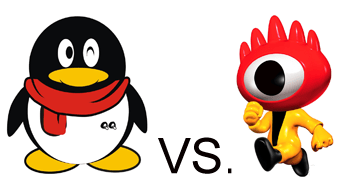China currently has the most Internet users of any country in the world, with some 420 million people connecting to the Web. Some more recent statistics even put that number as high as 485 million. Granted, China has a population of just over 1.3 billion, which means only 32 percent of its population is using the Web, a percentage far lower than the U.S. and Japan (at at 77 percent and 78 percent, respectively).
Of course, with web activity continuing to grow rapidly in China, the Asian power represents an enormous digital market, even as the so-called “Great Firewall of China” has made it difficult (or impossible) to fully transport international digital technologies and businesses into the Chinese ecosystem.
Thanks to China’s strict web regulation (and IP blocking, among other things), in the big picture, U.S. businesses have failed to make a significant impact, even in spite of the fact that China’s web users have begun adopting social networking, microblogging, gaming and more, with gusto.
Twitter has been blocked in China since 2009, for example, but that hasn’t stopped Chinese companies from adopting Twitter-like microblogging platforms at home. The use of “weibo” sites (the Chinese translation of “microblogging”) has exploded in China in the last few years, and two companies in particular have come to dominate the market: Tencent and Sina.
Of course, the matter of which company is winning the “weibo race” in China is open to debate. The reason for this is that Tencent has essentially become, as iChinaStock.com puts it, what AIM, Myspace, Facebook, and Twitter would be were they combined together into one, giant amalgamated enterprise.
Tencent’s IM application, QQ Messenger (a.k.a. QQ), claims to have 674 million active users, (although it’s very likely that estimate is high by several hundred million). QQ is the service from which Tencent signs up its users and then funnels them into its other products and services, including games, search, and Tencent Weibo, to name a few.
According to iChinaStock, microblogging in China really took off with the rise in popularity of Sina Weibo in 2009 and 2010; today, the popular microblogging service has nearly 140 million users. Yet, since Tencent launched Tencent Weibo in 2010, its service, too, has been growing at a breakneck pace, today claiming over 200 million registered users.
However, iChinaStock estimates that only about 93 million of those users are active on the service, and while this number remains open for debate, it is likely that as many as 40 percent of Tencent Weibo users are registering through QQ, which makes those registered stats run high, while in fact many of those users aren’t even active.
As always, the issue of identifying “registered” versus “active” users is delicate, and when it comes to these Chinese microblogging services, much of the data is either unpublished, unreliable, or an estimation.
Yet, in regard to which company is winning the race, Digimind, a solution provider that offers competitive intelligence as well as e-reputation, data mining and social media monitoring, has whipped up a nifty little infographic that gives us a peek into the Weibo War, and how the leaders stack up against Twitter. (See below)
While Digimind has Sina Weibo as the clear leader in China’s microblogging space, Tencent is certainly not to be dismissed, as it is growing exponentially, has an integrated, multi-level platform from which to channel users into its Weibo, and is spending millions on marketing to bring new users to its service.
That being said, those who I spoke to at Digmind, along with sources in China (as well as iChinaStock) all agree that Sina Weibo likely outranks Tencent in terms of the quantity of active users as well as the quality. With Sina owning 57 percent of the Chinese microblogging market and finding high adoption among Chinese celebrities (not to mention have a relatively stable platform without a lot of downtime), Sina looks like the clear frontrunner. Not to mention that the company acquired “weibo.com” and “weibo.cn” — two fairly important domain names for a company looking to dominate the weibo market. Plus, they’re just easier to remember.
While Sina Weibo compares favorably to Twitter in terms of adoption in China, the fact of the matter is that Twitter has a far broader reach, now being translated into 11 languages, whereas Sina and Tencent remain localized to the Chinese market. (Although Sina Weibo is planning to launch an English language version sometime soon.) Of course, it may be that the market is so huge that neither company will effectively become the “Twitter of China”, though Sina Weibo certainly seems to have the competitive advantage at this point.
However, with Tencent’s broader platform and patent ownership reaching into areas including instant messaging, e-commerce, online payment services, search, information security, and gaming, Tencent is diversified to say the least. And, with the massive adoption of QQ, perhaps it is Tencent that has first dibs on a bigger prize: China’s social graph.
Let us know what you think.
Further reading: For a really excellent comparison of Sina Weibo and Tencent (and Tencent Weibo), check out iChinaStock.com’s analysis here, and Bill Bishop of DigiCha’s analysis here.
Without further ado, the infographic:
Excerpt image courtesy of Technode

